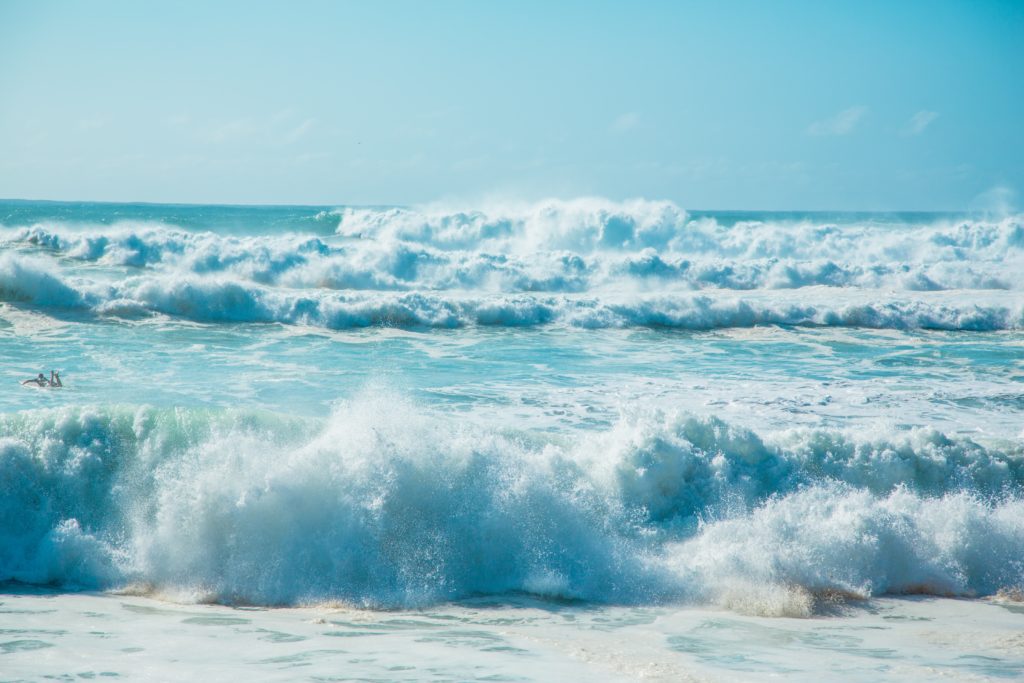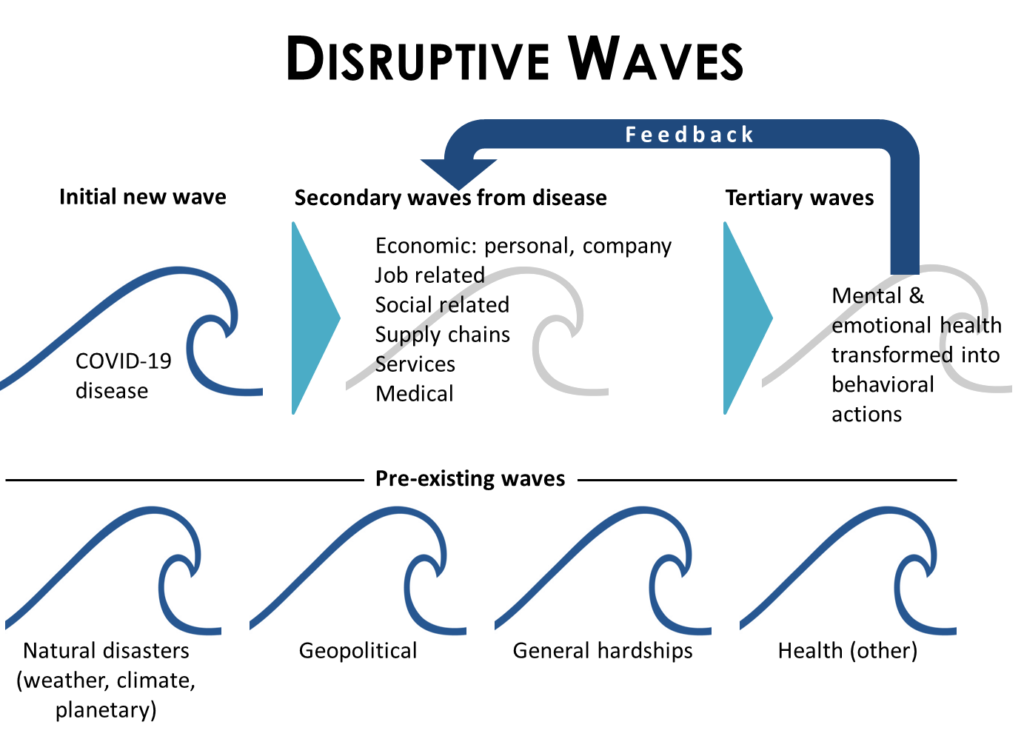
We are living in a world that is changing due to multiple, complex issues occurring at the same time. It can seem overwhelming to manage through this so I wanted to break it down. I began observing how people react to COVID-19 back in early March. I noticed aberrant behaviors as panic set. People began to hoard paper products. After toilet paper, cleaning products were in high demand. Every week or two, another product fell victim to this phenomenon and shelves were emptied in stores. I also noticed that news about COVID-19 hit us in waves. Each wave disrupted our lifestyles and our ability to function in a changing world. The disruptive waves are not just one wave but a series of waves constantly pounding us. COVID-19 gave us the primary wave.
SECONDARY WAVES
Every time a new story came out or social media offered its opinion, secondary disruptive waves pelted us along with the disease news and its set of disrupted waves. These secondary waves first hit us in our economy as fears drove stock prices down. Stay at home guidelines affected many of our jobs – another disruptive wave. Social relationships had new barriers with social distancing – another disruptive wave. A new type of secondary wave kept emerging over the months. Since we live in a connected world, one disruptive wave can trigger another disruptive wave. We see this now as supply chains get disrupted on different levels. We started with paper products and now we moved into food products. The recent exposure to COVID-19 at pork processing plants is causing a meat buying panic.
Secondary waves have these signatures:
Economic: personal
- Investments, cash flow, expenses
Economic: company
- Sales, production, delivery, channels, employees, business models
Job related
- Do I have a job, can I perform my job, job models
Education related
- Learning models
Social related
- Relationships, entertainment, vacations, and activities
Supply chains
- Food, goods, services, medical
Services
- Grooming, cleaning, medical
Medical
- Precautions, identification, treatment and care
- Assets: facilities, specialists, equipment
Disruptive waves are challenging our lifestyle and this alters our day-to-day reality. When our reality changes, it affects our behaviors as we try to cope and adapt with the changes. Our ability to adapt is based on how we react to the new norm and what behaviors drive our new thinking. Our inability to adjust and cope to the new norm can add stress and further impact our ability to function in the new environment.
TERTIARY WAVES
While we are being exposing to all of this chaos with secondary disrupted waves, we get pummeled by tertiary disruptive waves. These are due to the behavioral actions we take as our mental and emotional health is impacted from the continuing set of disruptive waves hitting us. We create these waves based on our actions. You see this in protests and some strange decision-making (hoarding and domestic violence). The tertiary waves can also amplify the secondary waves from the actions we take and transform them into a more destructive force.
Secondary waves can expose new behaviors in our being.
On the negative side, new behaviors can emerge out of frustration in coping and adjusting to disruption. These behaviors may look like:
- Pessimistic
- Defiance
- Deceit
- Anger
- Withdrawn
- Conflict
- Passive
- Societal breakdown
- Hoard mentality (me)
- Distrust
- Grateful
On the positive side, new behaviors can emerge out of hope and the internal belief that change from disruption can open new paths. These behaviors may look like:
- Optimistic
- Responsive
- Pro-social
- Confidence
- Investigative
- Active
- Creative
- Cooperative mentality (we)
- Trust
- Ungrateful
Mental health support is vital to minimize the creation of tertiary waves and stabilize the fabric of society.
PRE_EXISTING WAVES
Yet, there are another set of disruptive waves that have been with us all along for the journey. These are pre-existing waves and include natural disasters, geopolitical problems, general hardships, and health other than COVID-19. Most of us can manage through these waves since they are part of our everyday life and if a new pre-existing wave hit us, we can deal with it on a 1 to 1 basis. However, add these waves to the new waves created by COVID-19 and our ability to juggle all of this becomes difficult.
DISRUPTIVE WAVES
A diagram of the disruptive waves would look like this.

The actual destructive force to us is from the constant exposure to many disruptive waves that hit us one after the other. The destructive force to us is not just about getting the COVID-19 disease, the secondary waves occur from many other sources. As human beings, we realize we are now a punching bag from these hits and we need help.
I chose to call the “force of impact” a wave since it reminds me of being at a beach while watching waves constantly pound the beach and grind the shells into fine white sand. The waves always seem to win the battle of the beach. If you have ever stepping to the ocean during rough surf, it is an amazing experience of power as you get smacked by wave after wave. You cannot fight a wave especially if they come with a strong force and repeat one after the other.
The ability to adapt or collapse from the force of the waves seems to come from two things. One is our ability to embrace and manage change on a personal level. Each of us can help ourselves and one another with mental and emotional support thereby limiting the destructive impact of tertiary waves. The second is the need for leadership to guide us during troubling times on a community, business, or social level. Our ability to manage some of these waves is limited and high level leadership is required to help us through a coordinated effort.
COMPOSITION
To manage a wave, let’s look at its five properties and find solutions by understanding what the wave is and how they interact with one another.
- Composition
- Velocity
- Volume
- Periodicity
- Additive nature of waves
This article is not meant to provide solutions. Its purpose is to provide an understanding of the destructive nature of the forces that are changing how we live, work, and play. Through an understanding, you can develop solutions to address the threat. COVID-19 is an example of a primary disruptive wave but there will be more and they will take shape in various forms.
You cannot stop a wave but you can learn to adapt to it through understanding that in turn may alter the impact and nature of the disruptive wave.
This is a perfect time to embrace digital transformation. Connected businesses can adapt faster to rapid change and find their new sweet spot in the market as well as drive optimum customer experiences. COVID-19 nudged our world into chaos so be flexible and adapt quickly if you want to survive.